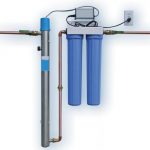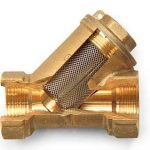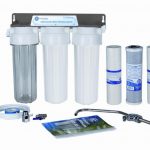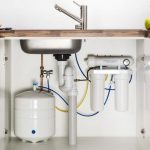 In the industrial field, very stringent requirements are imposed on water. It should be completely clean, as well as drinking. Most of all, these criteria apply to the following industries:
In the industrial field, very stringent requirements are imposed on water. It should be completely clean, as well as drinking. Most of all, these criteria apply to the following industries:
- Beauty products.
- Pharmaceutical products.
- Food products.
There are always various undesirable components in water. Typically, such a list includes various salts, iron particles, gases, and other contaminants. And for their elimination, industrial filters (PF) have been created. They qualitatively purify water at various enterprises. Their various modifications are involved.
Content
Area of use PF
In addition to the three above-mentioned areas of application, it is the production filter that is actively used in such areas
- thermal power;
- paper production;
- in glass factories;
- Agriculture.
Devices are used not only for water purification, but also for eliminating pollution from the already involved water sent to reservoirs.
Varieties of PF
As a rule, both enterprises use both technical and drinking water for the production process. The latter must be pre-processed. For this operation, usually use a technique that has a fairly simple design. These are devices for mechanical purification of water. Their industrial versions should not be confused with household ones.
Filters for industrial water purification have the following purpose: elimination of a variety of large solid particles. For example, it: silt, scale and other similar pollution.
Water in this technique can be filtered in two ways:
- Through the metal mesh. Features of the grids - the presence of cells of different parameters.
- Using sand, granular aluminum silicate and other similar bulk materials.
It is possible to remove solid impurities from water with the help of PF fine cleaning. The purpose of such devices is the elimination of the smallest organic formations and components with the presence of chlorine.
Here, the principle of purification is based on the use of carbon components called fillers. Devices can significantly develop the quality of water and technical, and drinking purposes.
PF are also often used for fine cleansing, which soften and deferred water.
The basis of their operating principle is the influence of various special reagents on water. In contrast to the modification of coarse (mechanical) cleaning, these devices do not have such large parameters. However, their operation is expensive.
Mesh appliances should work stably and efficiently. For this, it is periodically necessary to eliminate the accumulated pollution from them.
Fine refining models always require reagent replenishment at the end of one cycle. The installation of this technique is highly complex. The reason is the need for scrupulous and complex calculations.
Structural specifics of PF fine cleaning
The use of primitive mesh models in an enterprise is quite rare. Usually a technique is used whose shape resembles a flask, a pool or a solid (in size) tank with inlet and outlet openings. The reagent is concentrated inside the tank. It acts on water in the right way.
For cleaning operations, you can use not only chemical elements and coal, but also special bacteria. They can be aerobic or anaerobic.
In addition to a container with a reagent, the following components are included in the equipment of the device:
- Control unit.
- Distributors. One is centered. The second is below.
- Gravel backing.
Deironing devices
Such industrial units have become extremely widespread in industries. The reason for this is simple: because of the iron, which has dissolved in water, factory equipment, such as pumps, pipes, etc., is seriously clogged. The result for him is sad - various breakdowns and a rapid failure. To avoid this, it is necessary to properly and effectively remove iron from the water.
In modern models, the Greensend special environment is used for these tasks. This reagent has the format of fine sand. It is covered with manganese dioxide. The last element and oxidizes iron. The reagent can be applied under the influence of powerful temperatures. In some cases, a glaucon basis is used in this medium. In this case, ionization occurs. This is the most optimal method for applying the specified dioxide on this basis.
After filtration, sediment remains in the device. He throws himself into the sewer.
Still such PFs well remove water from hydrogen sulfide and manganese.
At the PF, whose purpose is iron removal, the work can be built on a different method. It does not imply the use of a reagent. Iron and some other impurities are oxidized inside the apparatus under the influence of oxygen. Oxygen is sent to the water, as it is affected by a powerful compressor. In order for this operation to proceed at a good speed, various catalysts must be used. Their examples are anthracite, quartz sand, etc.
Modifications for water softening
The principle of operation of these installations has many analogies with equipment for deferrization. There is only one distinguishing feature: a reagent that includes manganese dioxide or oxygen is not used. The key component here is the sulfonated copolymer. It is also called ion exchange resin.
The water hardness level is revealed by the proportions of the presence of ions of different salts in it. The device eliminates them. A key working component replaces removed ions with sodium ions. Thanks to him, after each stage of purification, the exchange capacity is restored. Recovery agent - standard table salt.
Scopes of softening models:
- All sorts of utilities. In this case, drinking water softens.
- Various boiler plants.
Disinfection equipment
Its most common area of use is the food industry. Previously, in order to eliminate pathogenic bacteria from water, ordinary chlorine was added to it. But this element in itself does certain harm. For this reason, in recent years, special technology has been actively used in the designated industry. It eliminates bacilli from the water by using UV rays. This method is considered very effective and absolutely safe for humans.
PF price indicators for water purification
The price tags of this equipment are primarily due to its varieties, the type of medium used and the level of efficiency.
The cost of mechanical models with grids ranges from 150,000 to 200,000 rubles.
The price tags of deferrization apparatuses are concentrated in the range of 30,000 - 70,000 rubles.
The price indices of coal modifications are similar: 40,000 - 80,000 rubles.
Serious expenses are obtained on softening units. Here figures from 50,000 to 100,000 rubles appear.
From all this, the conclusion suggests itself: PFs for water purification can have substantial prices. However, their benefits are great. They extend the life of the equipment, preserve the environment, and in rare cases help to develop the quality of products. Therefore, every self-respecting enterprise mounts such equipment in its workshops. Without these actions, a collapse can occur due to sudden equipment failure.





